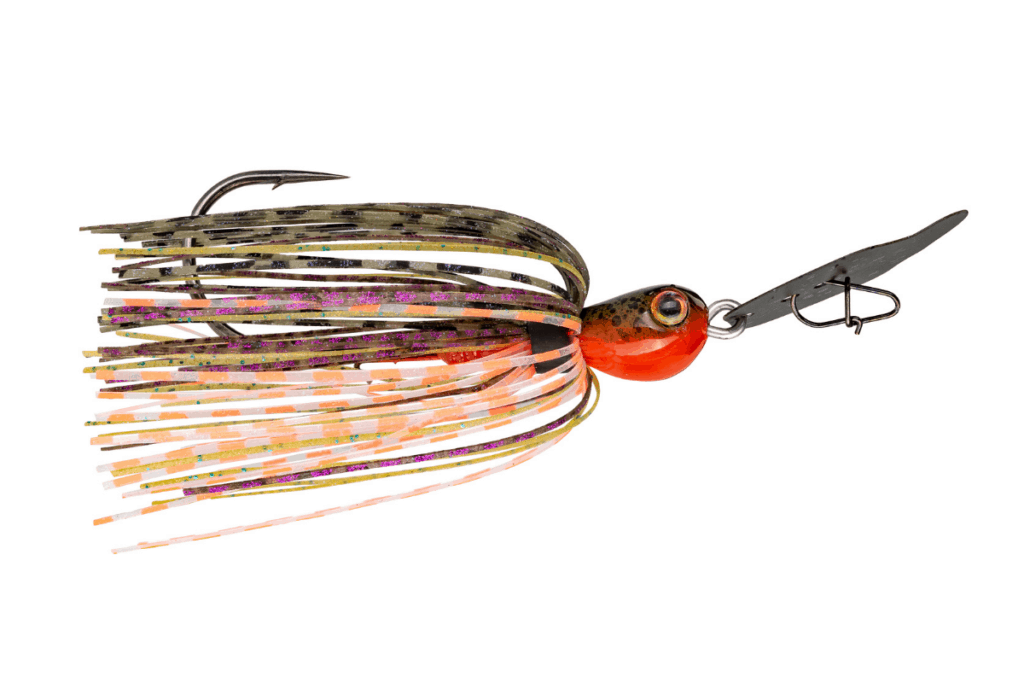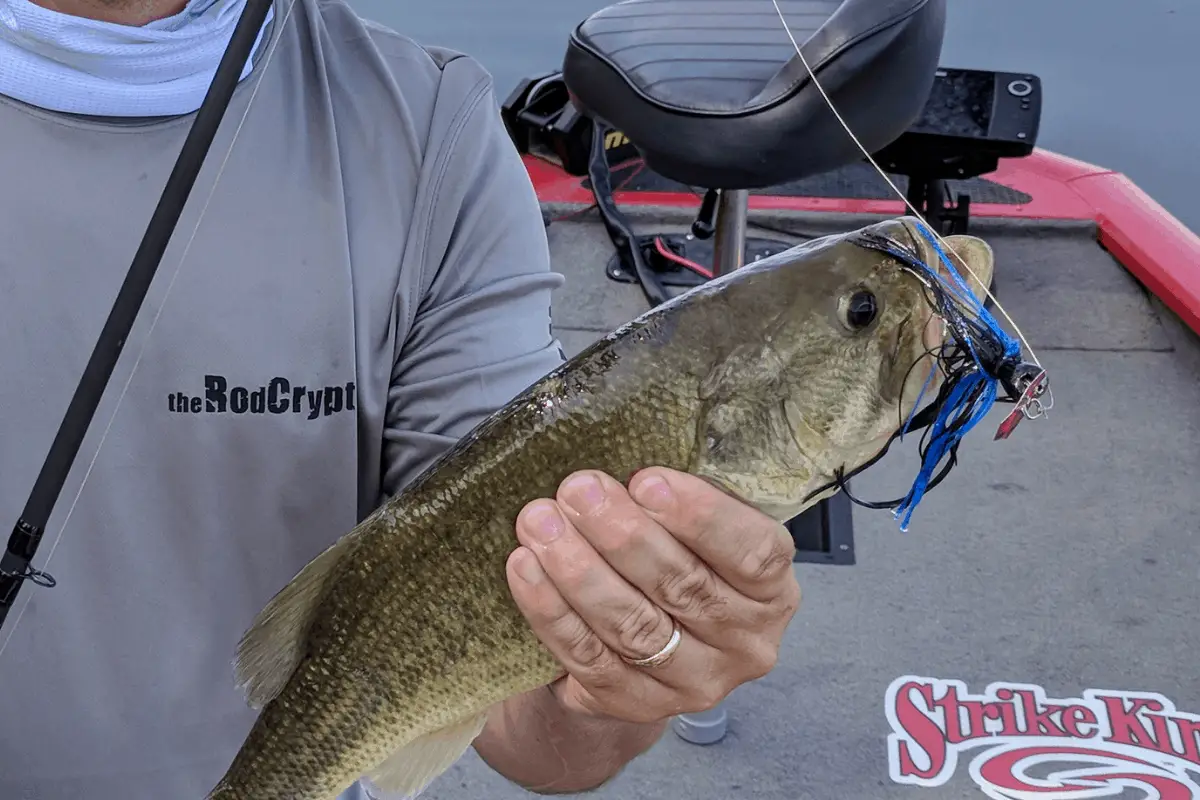There have been only a handful of lures throughout bass fishing history that have been “game changers.” The chatterbait is one of them. Also known as bladed jigs, these lures are now a staple in angler tackle collections across the country.
There are two distinct ways to fish a Chatterbait, or bladed jig. The first method is a straight chunk-and-wind retrieve through the water column. Variations in cadence, stop-and-starting, and banging the lure off cover and through vegetation improves this first method. Anglers also like to work a bladed jig along the bottom and bounce it through all sorts of structure and cover to elicit reaction strikes.
In this article, I will go into depth on this venerable lure, some popular methods to fish it, and why it is a fish-catching machine.
What is a Bladed Jig?
The Chatterbait, or bladed jig, is essentially a traditional jig that has a blade attached to it. This blade stands upright when retrieved and produces an intense amount of vibration.
The way the blade is attached has been the source of patent issues and unique alterations by numerous other manufacturers in the bass fishing arena. The original Chatterbait attached directly to the head of the jig. To avoid patent issues and legal battles, other companies designed their version with a split ring between the blade and the jig head. Does this make a difference? It does, but I’ll talk about that later in the article.
History of the Chatterbait
The story behind the creation of the Chatterbait is downright fascinating. Ron Davis, an angler from South Carolina, had been tinkering around with prototypes as far back as 2003.
He gives his father credit for the name of the lure. According to Bassmaster.com, “My father named it,” Ron said. “When we were working with prototypes in 2003, we couldn’t decide on a name. During a fishing trip to the Saluda River, he jokingly said the vibration was enough to make your teeth chatter. From that day forward, we referred to it as the ChatterBait.”
When professional angler, Brian Thrift, won a Stren Series event on the lure, things started to get crazy. Soon Ron Davis had orders for half a million baits and needed help. That is where the partnership with Z-Man was born, and the rest is history.
Bladed Jig Brands and Models
This is only a partial list
| Manufacturer | Model | Sizes | MSRP |
| Z-Man | Original Chatterbait | 1/4oz, 3/8oz, 1/2oz | $4.99 |
| Z-Man | Jack Hammer | 3/8oz, 1/2oz, 3/4oz, 1.25oz | $15.99 |
| Z-Man | Elite Chatterbait | 3/8oz, 1/2oz | $6.99 |
| Z-Man | Mini Chatterbait | 1/4oz | $3.99 |
| Strike King | Thunder Cricket | 3/8oz, 1/2oz, 5/8oz, 3/4oz | $13.99 |
| Picasso | Shock Blade | 1/4oz, 3/8oz, 1/2oz, 3/4oz, 1oz, 1.5oz, 2oz | $9.99 |
| Booyah | Melee | 3/8oz, 1/2oz | $8.99 |
Soft Plastic Trailers for Bladed Jigs
There are basically two types of trailers that I have found are the most effective on the back of a bladed jig: twin tail grubs/craws and single tail swimbaits.
Twin Tails
These are a favorite of mine because of the vast amount of water these lures can displace. This allows the angler to slow down their retrieve, yet maintain the position in the water column and not sink.
Twin tail grubs and craw trailers are also excellent choices when an angler wants to pop and drag a bladed jig through rocks and across bottom cover. The two appendages mimic crawfish and still provide ample vibration and water movement. When water clarity is dirty to stained, a bass’s lateral lines are critical to locating forage. This is accomplished with this style of soft plastic trailer.
Traditional green pumpkin and other craw colors are great choices when using a twin tail. If you like to swim your bait more than bottom bounce it, then other options like whites and silvers are a good choice.
Swimbait
If an angler wants to fish their bladed jig in a manner that will imitate baitfish, then a paddle tail swimbait is my favorite choice. The slender profile comes through grass and vegetation with ease and does a great job of complimenting the action of the blade.
Ribbed swim baits are a popular option, but a traditional soft jerkbait like a Fluke or Caffeine Shad will do the job.
As far as colors, match the forage base in the water you fish. If there are lots of shad or alewives in your home location, then whites, silvers, and grays are a perfect choice. If your primary forage base consists of bluegills, like on my home waters, then choose something with more greens in it.

Gear Used for Bladed Jig Fishing
I personally prefer to use a medium heavy rod anywhere from 7’ to 7’4” in length with a fast tip. I will match it up with either a 6.3:1 or 7.3:1 reel and spool that with braided line. I fish a bladed jig in primarily in dirty or stained water.
If you fish a lot of vegetation, grass specifically, you may want to consider using a medium action rod. This helps slow down how quickly the lure pops free of the vegetation when the lure gets tangled up in it. I personally have not found a lot of difference between the two, but there are lots of anglers that swear by the medium action rod when fishing thick grass, so it’s worth experimenting with.
Blade Start Up
This is probably the most crucial, and often overlooked, aspect of using a bladed jig. By referencing “blade start up” I mean how quickly the blade starts to vibrate. At first, this doesn’t seem like a big deal, but it is. This is especially critical when fishing bladed jigs in-and-around cover. When fishing tight pockets, brush piles and laydown trees, and patches of vegetation, you want that blade to start vibrating immediately.
Some models, especially those that do not connect directly to the jighead, start up slower. This will result in a direct correlation to the number of bites that you get.
If you spend most of your time using a traditional chunk-and-wind retrieve, this is probably not a big deal. Keep in mind though, that each time your bladed jig bumps into wood, grass, or anything else, the blade needs to start up again. Blade start up is something to keep in mind if you are not getting as many bites as you hoped.
Retrieve for a Bladed Jig
There are three types of retrieves that are very effective when fishing bladed jigs. The first is pitching and flipping around cover. Run that bladed jig down the length of a laydown tree, pound it into a dock piling, or rip it through a patch of thick vegetation. In other words, fish it very similar to how you would a traditional jig.
Where this bait may shine above others is during an open water retrieve, especially in stained to dirty water. Just cast it out and reel it back, but make sure that you vary the retrieve on the way. Pulse the lure, twitch it with the rod, or even just make a quicker turn with the reel handle. Yes, a straight retrieve will work, but varying the retrieve will trigger fish that are following the lure.
The last type of retrieve is to bounce it along the bottom. Let the bladed jig sink to the lake bed, and then start it moving with a quick pump of the rod. Then reel it back, slowly, while maintaining contact with the bottom the entire time. This is the type of retrieve where you will want to make sure to use a twin tail grub or craw trailer. A heavier bladed jig, like 3/4oz or heavier, will also help you keep bottom contact.
Types of Water you Fish
As I mentioned earlier in the article, I primarily use a bladed jig when the water has some color to it. If the water is complete mud, then so much the better. I have had great luck in these situations, but that shouldn’t discourage you from fishing a bladed jig when the water is clear.
This lure is great at eliciting reaction strikes. Even in clear water, you can bang and pound this lure into all sorts of cover. I have found that a bladed jig also works really well in clear water on days when boat traffic has things stirred up.
Final Thoughts
Just about all anglers have a bladed jig, but there is only a select group that has a lot of confidence in it. I fell into the latter category until recently. It is not a gimmick and deserves a place in your stock of bass catching lures.

